在擬石蓮花屬中根據其葉片,顏色特性再細分五類,想想也挺有趣的,下文作者是台灣花友alo(阿肉)在韓國網站上看到關於擬石蓮花屬的分法後整理分享給大家參考,事實上更科學的劃分法有17類,可參考文末,英語好的同學可以幫忙翻譯翻譯。文中的品種名字叫法雖然有些不一樣,但猜猜基本還是能猜對,大家可以比較比較。
看到某個韓國網站介紹多肉,對擬石蓮花屬(Echeveria)用葉形狀、顏色分成5個種類。
在這邊分享給各位,當然許多品種實在是你說他屬A類也可以、B類也可以…
此區分法並非絕對,但提供了明確的分類大項,很有趣的觀點。
園藝是門專業的學問,能夠更多人討論、收斂、歸納。
因而找出更好精細科學的方法,這亦是玩花種花之外的另一個樂趣。
歡迎大家能夠一起討論,這才好玩嘛!
1. 單一葉(Accents)
單一葉是指葉形狀單一、基底色單純(不考慮因低溫缺水變色狀況)
像東雲系、卡羅拉等歸類在這一類中,看例的舉子是指葉形像下圖的:
亦即葉形由莖向葉尖是慢慢縮小,不會再出現其它變化。

以這個基礎來說,東雲沒有什麼大問題,基本上桃太郎、吉娃娃、卡羅拉也是。此外像霜之朝、藍鳥、墨西哥巨人也歸屬在這類中
白鳳、吉娃娃
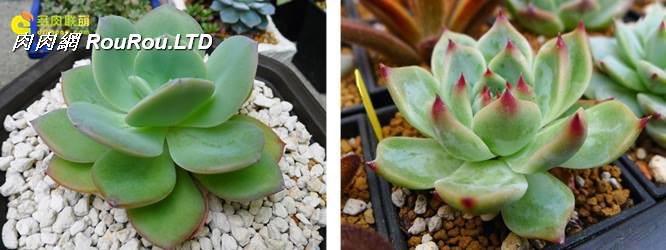
東雲平安夜、藍鳥
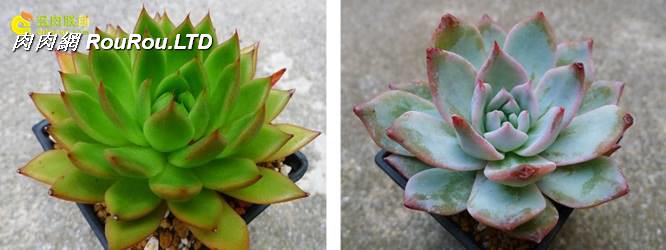
照這個分類基礎來說,黑王子、凱特、藍金屬等也算是單一葉類吧~
呃……看起來似乎不是,所以接著我們來看看第二類吧~
2. 彩色葉(Colours)
在上述單一葉形的基礎上,如果葉片顏色有變化,就會歸類在彩色葉。
顏色可呈現2種(含)以上,就屬於這類。
但這問題就來了,像吉娃娃的葉背是紅色,但基底是綠色,不也兩種?
這就需要將定義再說的明顯一點,個人認為啦。
葉片中的多種顏色是可以出現在葉片所有地方,而不是特定點,且顏色變化明顯。
舉個例,最常見的市場肉黑王子和大銀明色。
黑王子和大銀明色一樣,如果沒曬太陽就會變成”綠王子”和”大綠明色” XD
在正常露養環境下,黑王子的黑色會有很多種變化,甚至也會同時保留綠色成份
黑王子、大銀明色
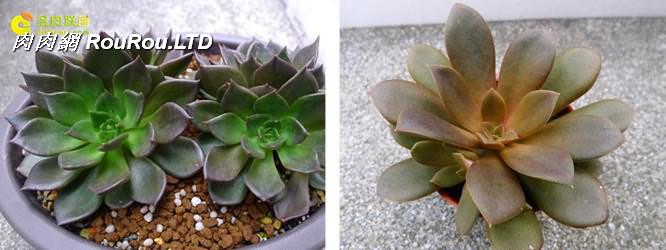
當然最好分的就像是飾蓮、七變化、彩度、晚霞這些同時有明顯多種顏色的
不過在這裡我就有些疑問了,像織錦、萊姆辣椒這類天生有黃色錦線條的。
也算在彩色葉這類?還是要忽略錦條算在單一葉呢?
飾蓮、紫嘯鶇
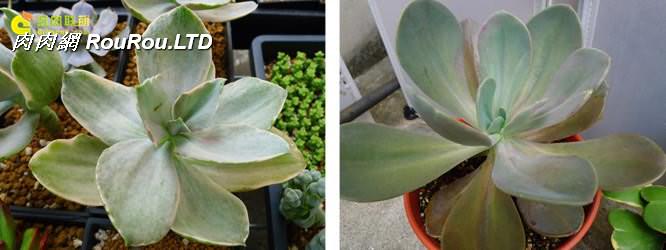
萊姆辣椒、織錦
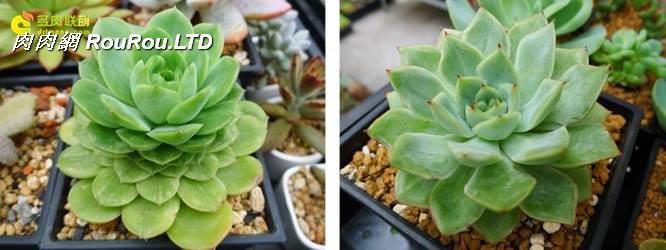
3. 幾何葉(Geometrics)
幾何泛指葉片形狀多變,不像單一葉的形狀簡單
在這分類中似乎不考慮顏色,只要葉形有變化都歸在此類中
簡單來說,只要葉片末端忽然胖起來的都算
常見有特葉玉蝶、老樂、蘿拉、桃之嬌等
不知像大瑞蝶這種葉片會內凹的算不算在此類?
特葉玉蝶、紅日傘
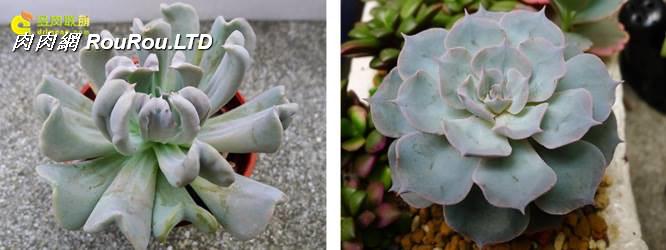
桃之嬌、蘿拉
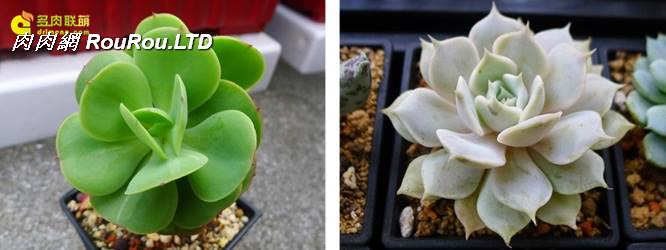
4. 卷褶葉(Frills)
此類就是大家俗稱的高麗葉品種,大多是以沙薇娜為主的園藝種或雜交種。
而這類很多都是由美國加州知名的園藝大師 Dick Wright 所雜交出來。
特點就是葉片末端呈現蕾絲卷褶狀,通常葉片都較薄。
很多卷褶葉的擬石蓮都是中大型種,養起來特有成就感呢~
有趣的是,這類有些品種也包含彩色葉的特性,像昂貴的飛翔雲 XDDD
晚霞之舞、米娜斯
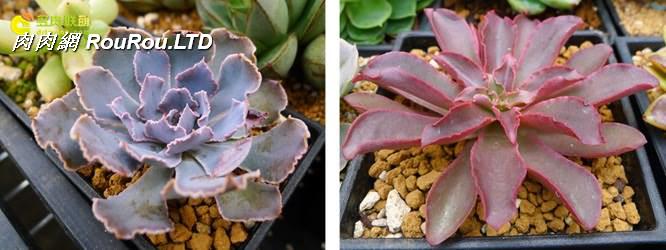
Zorro(黑羅勒?)、晨光
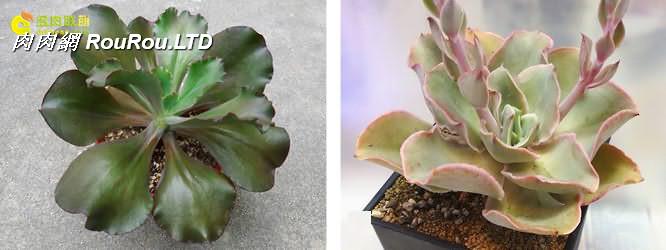
5. 瘤狀葉(Bumps)
只要葉片上有瘤的,都算此分類
同樣的,很多也出自於Dick Wright之手
至於瘤,在幼年期時是不會有的,通常都要成長到一個階段後才會浮現
這也是為何常有人把女王花笠和高砂之翁的小苗給搞混了
瘤發生的機制還不明,有一學說是病毒感染的關係
當然瘤出現的功能也不明,莫非是讓動物覺得噁心不想去碰? XDDDDDD
總之瘤狀的擬石蓮,審美觀真的是各人各有不同見解
像雨滴、女王花笠的瘤就蠻多人喜愛的
但乙女之夢、狂野男爵,似乎就沒有那麼多人欣賞
狂野男爵、女王花笠狂
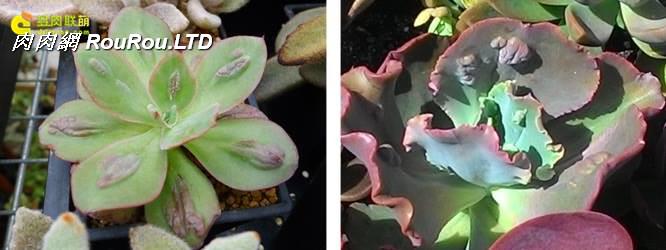
李錫堅老師補充的資料,Walther將擬石蓮屬分為14類
之後Myron Kimnach於2003加以補充,將143個品種分為17類
於ICN上可看到James E. Low發表的文章簡短地概述了這17類的分類(英語好的同學可以幫忙翻譯翻譯):
1. Angulatae, [Roots often tuberous; stem nearly lacking; small, narrow leaves; the inflorescences with one to several cincinni; petals acutely keeled and thick]. Now with 10 species.
2. Chloranthae, [Stems nearly lacking; infl. with 1 cincinnus; petals short and stout, green in color and obtusely keeled]. Only 1 species.
3. Ciliatae, [Stems short to medium; leaves pubescent (hairy) to glabrous (no hairs); infl. racemose or paniculate and often hairy]. Now with 8 species or ssp.
4. Echeveria, [Stems medium to tall; minutely puberulent to hirstute (fine to medium hairs); infl. a spike or equilateral raceme; often pubescent]. Now with 9 species or ssp.
5. Gibbiflorae, [Stems short to medium; glaberous (no hairs); infl. a paniculate cyme (a 「thyrse」) with branches being a cincinni, rarely pubescent]. Now with 22 species or ssp.
6. Longistylae, [Stems nearly lacking; leaves glabrous (without hairs); infl. with 1 or 2 cincinni; corolla to 3 cm. long; styles 2 cm. long]. Now with only 1 species.
7. Mucronatae, [Roots tuberous; stems nearly lacking; leaves glabrous & small; infl. spicate or sub-racemose; petals to 2 mm long]. Now with 3 species.
8. Nudae, [Stems tall; leaves glabrous or papillose (hairless to fuzzy); infl. a raceme, rarely a spike]. Now with 25 species or ssp.
9. Occidentales, [Roots not tuberous; stems nearly lacking; leaves small to medium; infl. a cyme, much-branched apically, with cincinni; corollas red]. Now with 2 species.
10. Paniculatae, [Roots not tuberous; stems short; leaves small & glabrous; infl. cymose-paniuculate, with cincinni; corollas very small]. Now with 3 species.
11. Pruinosae, [Stems short; leaves small to medium and pruinose (white-frosted) to glaucous; infl. with 1 to 3 cincinni; petals thick]. Now with 3 species.
12. Racemosae, [Roots tuberous or fibrous; stems nearly lacking; rarely tall; leaves usually glabrous, rarely pubescent; infl. a raceme]. Now with 33 species or ssp.
13. Secundae. [Roots not tuberous; stems nearly lacking or short; leaves glabrous, small, usually glaucous; infl. with 1 or 2 cincinni; petals obtusely keeled]. Now with 6 species or ssp.
14. Spicatae, [Stems tall; leaves narrow & glabrous; infl. densely spicate or racemose; sepals often longer than the corolla; petals obtuse and keeled]. Now with 2 species.
15. Thyrsiflorae, [Roots tuberous, stems nearly lacking; leaves glabrous; infl. thyrsoid or sub-racemose and determinate]. Now with 3 species and ssp.
16. Urbiniae, [Roots not tuberous; stems nearly lacking; leaves small, glabrous, and often glaucous; infl. second-racemose; corollas urceolate (urn-shaped)]. Now with 19 species or ssp.
17. Valvatae, [Roots not tuberous; stems nearly lacking; leaves thin and acute margined; infl. with 1 or 2 cincinni, bract leaves imbricate; sepals about as long as corollas, petals valvate: not overlapping]. Now with 2 species.

 多肉植物
多肉植物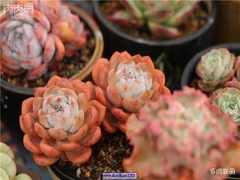 35種好養好看好度夏的擬石蓮屬多肉(共48張圖片)
35種好養好看好度夏的擬石蓮屬多肉(共48張圖片)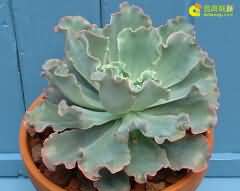 擬石蓮花屬園藝品種雜交培育歷史
擬石蓮花屬園藝品種雜交培育歷史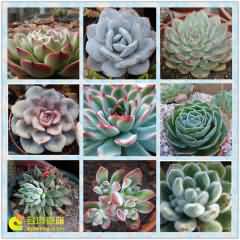 擬石蓮花屬的簡介及種植養護
擬石蓮花屬的簡介及種植養護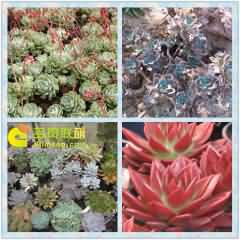 擬石蓮花屬的種植養護及繁殖
擬石蓮花屬的種植養護及繁殖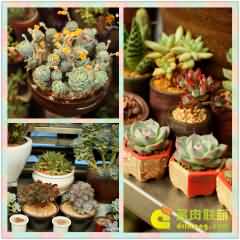 景天科石蓮花屬多肉植物圖鑒+常見多肉種植養護問題解答
景天科石蓮花屬多肉植物圖鑒+常見多肉種植養護問題解答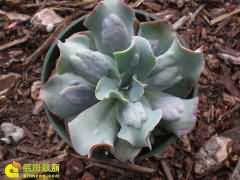 擬石蓮花屬多肉植物怎麼授粉雜交
擬石蓮花屬多肉植物怎麼授粉雜交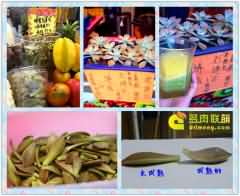 可以吃的石蓮花
可以吃的石蓮花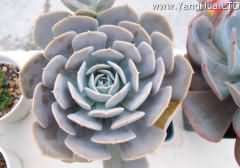 魯氏石蓮花與皮氏石蓮花的區別:仔細觀察兩者葉形是可以區別出來的
魯氏石蓮花與皮氏石蓮花的區別:仔細觀察兩者葉形是可以區別出來的